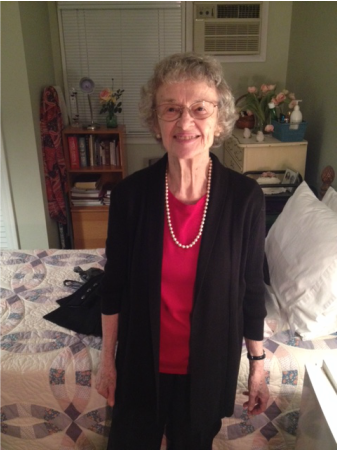|
(My mother-in-law passed recently at the age of ninety-three. Her grand-daughter, Corinna V. Wilson, composed an obituary, from fond memories.)
By Corinna V. Wilson On February 1, my grandmother, Mary Mase, passed away. She lived many years in Levittown and Shelter Island NY; Bloomsburg and Camp Hill, PA, and Leesburg, FL. Mary Betsy Grundy was born on April 3, 1921 in Ledyard, Connecticut. She and her twin brother Elwin were the second and third of eight children born to Betsy Crouch and Harold Grundy. Harold had emigrated from England as a young man while Betsy’s family had been in the United States since 1633, when Noah Whipple landed in the colony of Massachusetts. One of my grandmother’s ancestors, Stephen Hopkins, signed the Declaration of Independence on behalf of the new state of Rhode Island. Life on the Grundy farm was not easy, and Mary told stories of selling apples door-to-door during the Depression and of the kids going without shoes in the summer to save money. To survive, Harold got a job on the railroad, Betsy opened a bakery in New Haven, and the family operated a boarding house in Orange. Later, they moved to a farm in Waterbury, where Mary met her future and former husband, George Graham. Mary always said that the invention of double-knit was the greatest thing because she had ironed all of the laundry for her big family and their boarders and really didn’t want to iron ever again. To the end, Mary was also a tremendous baker and could teach anyone how to make the perfect pie crust. The Grundys were religious people, and Mary’s deep faith in God sustained her throughout her entire life. She often spoke of talking with Jesus directly and of his multiple interventions in her life. Mary was preceded in death by only two of her siblings – her twin and her baby brother, Tommy. Donald, Harold, Pearl, Bettina, and Lila all survive her and are still formidable in their own right. Mary was also predeceased by her son, Edward Mase. Her remaining four children, Marianne (my mother), George Lauren (Larry), Peter, and Rachel survive. Mary has 16 grandchildren and 14 great grandchildren. Mary married her second husband, our “Grampa,” Richard Mase, in 1947. After his death in 1988, Mary remarried two more times, to Ariel Eisenhauer and Marlin Reisinger. Still attractive to the end, Mary received a marriage proposal when she was just shy of 90, which she declined, despite the amused teasing of her grandchildren that she could be like the Pittsburgh Steelers and have “one for the thumb.” Mary’s long life had many chapters. She was a jewelry model and worked in a munitions plant in Groton during World War II, an original “Rosie the Riveter.” She was an accomplished seamstress and quilter. She made the best gravy of anyone, ever, and her pin always matched her blouse. She taught her grandchildren how to clam the sandbars of Long Island and she prided herself on being a homemaker and a perfect size 6. Ninety three years is a long time to live and our family is going to have to adjust to her absence. (We are thankful to Corinna for expressing what we feel.)
Altenir Silva
2/6/2015 11:22:04 am
RIP Mary Mase.
George Vecsey
2/6/2015 12:49:43 pm
Muito obrigado, GV
Mendel
2/7/2015 08:49:16 am
I am sorry for your family's loss, George.
George Vecsey
2/7/2015 10:57:35 am
Mendel, thank you, George
Mike from Whitestone
2/7/2015 12:12:00 pm
My condolences to you all GV.
bruce
2/7/2015 05:47:29 pm
George,
Hansen Alexander
2/8/2015 04:12:46 am
A delightful, charming tribute. She's not afraid to use semicolons either! I love it.
George Vecsey
2/8/2015 07:37:19 am
A whole week at law school on the implications of the semicolon. 2/8/2015 07:27:35 pm
Hello, just wanted to say, I loved this article. It was practical.
Greg Amante
2/14/2015 11:09:09 pm
George, Comments are closed.
|
Categories
All
|










